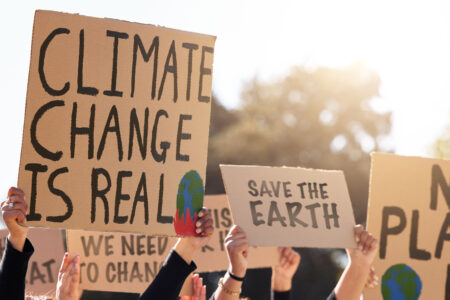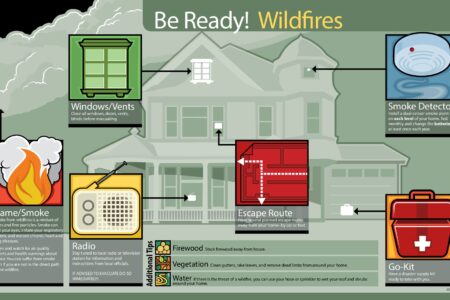
Share On Social!
The summer of 2023 was one of the hottest seasons on record for some areas across the US, bringing sweltering temperatures that caused heat stroke and heat exhaustion.
Experts see this as a prime example climate change endangering health.
While extreme weather events like heat are nothing new, the frequency of these events is cause for concern, especially when it comes to health and well-being.
To tackle some of these issues, the World Health Organization (WHO) has launched a new toolkit to help healthcare professionals arm themselves with knowledge about climate change and health.
Communicating on climate change and health toolkit for health professionals discusses the ways to start difficult conversations about climate change with patients, other providers, and officials, and find helpful solutions that benefit overall health.
“Health and care workers play a key role in addressing climate change as a health crisis. Their unique position enables them to raise awareness, advocate for policy changes, and empower communities to mitigate and adapt to climate change,” said Dr. Maria Neira, Director, WHO Department of Environment, Climate Change and Health.
“By engaging in dialogue and action, health and care workers can catalyse efforts to safeguard human health as well as ensuring a resilient and sustainable future for all.”
Climate Change
Climate change is classified as “long-term shifts in temperatures and weather patterns,” according to the United Nations.
While natural changes can occur, the danger in climate change lays in human intervention, such as burning fossil fuels like coal, oil, and gas.
The burning of these fuels causes the emission of greenhouse gases, such as carbon dioxide and methane, that wrap around the planet and trap heat from the sun and can raise temperatures.
These fossil fuels can come from something as simple as using gas in your car or burning coal to heat a building.
Meanwhile, clearing land and cutting down trees can release carbon dioxide. Agriculture, oil, and gas operations can produce methane emissions. Energy, industry, transport, buildings, agriculture, and more can cause greenhouse gas emission, according to the United Nations.
These fossil fuels have been widely used since the 1800s during the industrial revolution and have been a mainstay of big industries, which have only grown in recent decades.
For that reason and many more, WHO states that climate change is the biggest health threat of the 21stcentury.
Climate Change’s Impact on Health
Climate change is the center of a lot of conversations, including its impact on health.
There are many potential health consequences that stem from climate change, including impacting the social determinants of health, such as access to healthy food and safe places to play outside.
Changes to the earth’s climate have ushered in many heatwaves, which have been known to cause heart attacks, kidney disease, cardiorespiratory diseases, decreased mental wellbeing, and death.
Extreme heat is also a threat to mental health.
When extreme heat events occur, many are kept indoors and away from activities, culture, events, social outings, and more.
What’s more, exposure to extreme heat can cause trauma and create anxiety about the future, according to WHO.
As the weather changes, crops and animals struggle to adapt leading to a reduction in food supply, which could cause food insecurity and malnutrition.
Climate change also impacts the world’s water supply.
Extreme heat can cause periods of drought, leading to fewer water resources and even potential contamination due to competition for scarce resources.
Weather pattern changes also keep mosquitos out longer, increasing the risk for mosquito-borne illnesses and diseases.
However, the largest threats from climate change come from air pollution.
According to WHO, 99% of the global population breathes in unhealthy air due to the burning of fossil fuels. Fossil fuels are linked to chemical intolerance, too.
Air pollution can increase your risk for asthma, lung cancer, strokes, and more.
Climate Change and Latinos
Latinos are at higher risk for developing conditions associated with air pollution.
A 2019 study estimates that Latinos experience 63% more pollution than their consumption activities cause.
Exposure to air pollution can lead to health complications such as asthma — a condition with a higher prevalence in Latinos and other populations of color.
In 2018, an estimated 2.3 million Latinos were reported to have asthma with Puerto Rican Americans accounting for twice the asthma rate of the Latino population, according to the US Department of Health & Human Services’ Office of Minority Health.
When it comes to asthma-related hospital visits, Latinos are twice as likely to go, compared to non-Latinos.
Asthma can even be more common in areas with high Latino populations.
In Austin neighborhoods where many Black and Latino residents reside, asthma-related trips to the ER have increased due to air pollution.
Air pollution may also contribute to the rise in Latino childhood obesity.

Children whose mothers were exposed to air pollution while pregnant had a high rate of obesity, according to the State of Childhood Obesity report from the Robert Wood Johnson Foundation.
Obesity could lead to other adverse health effects such as diabetes, increased risk for heart disease, and other weight-related problems later in life.
Latinos are also disproportionately impacted by climate change because of where they live and work, according to a report by the Environmental Defense Fund.
55% of Latinos live in states that are prone to climate change effects like the drought in California, the record-breaking heat in Texas, and rising sea levels and flooding in Florida.
What’s more, Latinos make up a large portion of outdoor industries like agriculture, manufacturing, and construction, which increases exposure to the elements.
“The majority of the Latino population, from mainland Latinos to Puerto Ricans, lives at the forefront of climate change. They’re first and hardest hit,” Michael Méndez, an assistant professor of environmental policy and planning at the University of California, Irvine, told Yale Climate Connections.
Many Latinos also live in neighborhoods that lack trees and green spaces, which help keep neighborhoods cool in the event of a severe heat event.
To address this issue, some cities, like San Antonio, have installed cool pavements in underserved neighborhoods to help communities break from the oppressive heat.
Climate Change Solutions
Implementing solutions, such as installing cooling pavements in cities, has the potential to mitigate climate change while helping to build better health equity, community resilience, and promote healthy living.
For example, projects like clean energy and transportation, nature preservation, and urban greening can improve air quality, increase physical activity, reduce urban heat effects, and improve mental health, according to WHO.
Decreasing greenhouse gas emissions can also save money in the long run. Individuals can save $2 in health costs for every dollar spent on green initiatives, especially if these initiatives involve the health sector.
The health sector accounts for around 5% of global emissions.
“When health systems implement climate solutions and shift to clean energy, it both reduces their contribution to global emissions, and improves their capacity to manage disruptions from extreme weather events, pandemics and other health crises,” according to WHO.
To further improve emissions, health systems can develop early warning systems, work on emergency preparedness, and increase public education and awareness.
Health Professional Communications Strategies
So how can healthcare professionals get involved?
An important way health professionals can improve climate change is by using their expertise, trustworthiness, and position as a voice of authority to educate their patients and communities about the impact climate change has on health.
WHO believes that:
- Talking about climate change as a health issue has considerable potential to build public support for climate solutions.
- Many health professionals are willing to talk about climate change and engage in climate advocacy.
- Health professionals are highly trusted to talk about climate and health.
- The existing evidence supports the unique role that health professionals have in building support for climate action.
WHO created its new toolkit for health professionals to use to get their point across to a variety of community members, policymakers, and social media.
Effective communication includes keeping the message simple and repeating it frequently, focusing on the health effects of climate change and localizing it, and staying away from difficult technical terms and avoid using polarizing language like “climate emergency” or “crisis.”
Other tips consist of using climate change to empower people to make better health decisions, discuss the health benefits of climate action, humanize climate change by telling stories, using extreme weather events as “teachable moments,” and not digging into the science of climate change.
There are also ways to get the message across without having one-on-one conversations.
Community outreach could include displaying climate change visuals in offices and waiting rooms and sharing related climate change messages on your workplace website or social media accounts.
When in doubt, you can always practice giving climate change health advice with a trusted colleague.
Health professionals are encouraged to download the toolkit for more outreach examples, sample messaging, and more.
Latinos Want to Tackle Climate Change
Not only are Latinos more affected by the effects of climate change, Latinos are also more likely to do something about it.
Latinos were found to be more likely than their white peers to acknowledge human activity’s impact on climate change and to support policies and other actions to protect the environment, according to a report by the Environmental Defense Fund.
Latinos are at the forefront of many efforts to reduce the harmful effects of climate change where they live.
One of the ways Latinos are doing this is by garnering community support to usher in change.Organizations like Green Latinos and Latino Outdoors are promoting advocacy.
A bi-annual event by the name of Naturally Latinos is doing this on a larger scale in hopes that a flood of Latino support can make an impact.
“For the longest time, it was a matter of perception, that Latinos didn’t care, or were unaware of the environmental issues that we face today,” Serenella Linares, the co-chair of Naturally Latinos, told Maryland Matters. “These [are] really big perceptions [about us] that we need to fix.”
Not only are Latinos aware of the issues, but they also express something needs to be done.
Half of US Latinos believe a large-scale effort needs to be made to reduce global warming, compared to 33% of non-Latinos, according to a recent English and Spanish survey by the Yale Program on Climate Change Communication, which was included in a Salud America! report.
Tackle Climate Change and Health Equity Where You Live
Climate change can be overwhelming.
It can be difficult to know where to start.
But the reality is being a climate change warrior starts in your own backyard.
Download a free Health Equity Report Card by Salud America! at UT Health San Antonio today to learn about the challenges your community faces when it comes to climate change and other health issues.
Select your county and you will get maps, data, and graphs on issues like transportation and pollution that keep the people in your community from living their healthiest lives.
Compare it to the rest of your state or the entire US for a better measure of health equity where you live.
With this tool you can visualize the problem and seek solutions by proposing your own green initiatives, organizing a volunteer day, or even to gain support in starting a neighborhood garden.
GET YOUR HEALTH EQUITY REPORT CARD!
Explore More:
Air QualityBy The Numbers
24
percent
of Mexican American-nonsmokers are exposed to secondhand smoke



